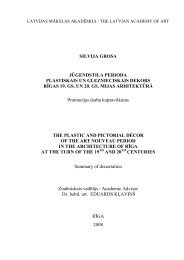Institute of Art History of the Latvian Academy of Art Anna Ancāne ...
Institute of Art History of the Latvian Academy of Art Anna Ancāne ...
Institute of Art History of the Latvian Academy of Art Anna Ancāne ...
You also want an ePaper? Increase the reach of your titles
YUMPU automatically turns print PDFs into web optimized ePapers that Google loves.
common in a geographically vast area in <strong>the</strong> 2 nd half <strong>of</strong> <strong>the</strong> 17 th century; it<br />
is illustrated by <strong>the</strong> versions <strong>of</strong> <strong>the</strong> French architect Pierre Le Muet and<br />
<strong>the</strong> rich but restrained solutions <strong>of</strong> burghers’ houses by Nicolaus<br />
Goldmann.<br />
IV. 4. Front-gabled houses<br />
Part <strong>of</strong> <strong>the</strong> front-gabled houses on <strong>the</strong> narrow building plots were rebuilt<br />
and survived in <strong>the</strong> Baroque Riga, retaining <strong>the</strong> walled-up windows <strong>of</strong><br />
Gothic niches; <strong>the</strong>ir pyramidal rhythms coincided with <strong>the</strong> silhouettes <strong>of</strong><br />
Baroque lines. The gabled façade <strong>of</strong>ten featured two or three symmetrical<br />
windows on different floor levels. Several front-gabled houses have been<br />
preserved in Riga – at 20 and 22 Lielā Pils Street, 8 and 12 Jāņa Street,<br />
17/19 Mazā Pils Street. In 1823 similar gables were found at 4 Krāmu<br />
Street, 6/8 Mūku Street, on <strong>the</strong> corner <strong>of</strong> Monētu and Šķūņu Streets etc. A<br />
typical example <strong>of</strong> a front-gabled house was <strong>the</strong> building at present 4<br />
Mārstaļu Street with four massive buttresses on <strong>the</strong> cornice level.<br />
Analogies to <strong>the</strong> Nor<strong>the</strong>rn German examples, like those in Wismar,<br />
testify to a quite ancient type <strong>of</strong> dwelling house.<br />
A large part <strong>of</strong> front-gabled houses in urban architecture was storehouses.<br />
They were especially concentrated around Alksnāja, Peitavas, Miesnieku<br />
and Vecpilsētas Streets.<br />
IV. 5. Side-gabled houses<br />
This group is <strong>the</strong> largest by numbers, as it reflects <strong>the</strong> average level <strong>of</strong><br />
construction and not all objects were <strong>of</strong> equally high artistic quality. The<br />
average functional architecture was <strong>of</strong>ten far removed from original<br />
impulses, in addition, stylistic influences <strong>of</strong>ten overlapped. The main<br />
indications <strong>of</strong> change were found in layouts, façade proportions and<br />
composition <strong>of</strong> windows. The lacking risalits and pediments were<br />
replaced by symmetrical or nearly symmetrical façade with corner<br />
rustication, wide windows and a representative portal. Instead <strong>of</strong> <strong>the</strong><br />
colossal order pilasters many were content with a smooth, plastered<br />
façade. Examples were at 16 Mārstaļu Street, 24 Jauniela, 12 Aldaru<br />
Street, 21 Peldu Street etc. The composition <strong>of</strong> three windows was very<br />
wide-spread, for instance, at 24 and 26 Smilšu Street. More wealthy<br />
citizens bought <strong>the</strong>ir neighbours’ building plots and acquired more up-todate<br />
houses, uniting two front-gabled buildings (at 22 Grēcinieku Street,<br />
6 Audēju Street). Practical concerns <strong>of</strong>ten caused deviations from <strong>the</strong><br />
symmetry <strong>of</strong> facades (at 20 Smilšu Street). A tendency to change <strong>the</strong><br />
directions <strong>of</strong> ro<strong>of</strong> slopes and to use <strong>the</strong> old structure <strong>of</strong> walls to <strong>the</strong><br />
maximum is evident in <strong>the</strong> building at 10 Audēju Street that was rebuilt<br />
in <strong>the</strong> 2 nd half <strong>of</strong> <strong>the</strong> 17 th century. Its construction history manifests a<br />
typical transformation process leading to <strong>the</strong> Baroque side-gabled house.<br />
A building has been mentioned at Svērtuves (Šāļu) Street, built “after <strong>the</strong><br />
fire <strong>of</strong> 1677”. All buildings within <strong>the</strong> district had ei<strong>the</strong>r two and a half or<br />
16












